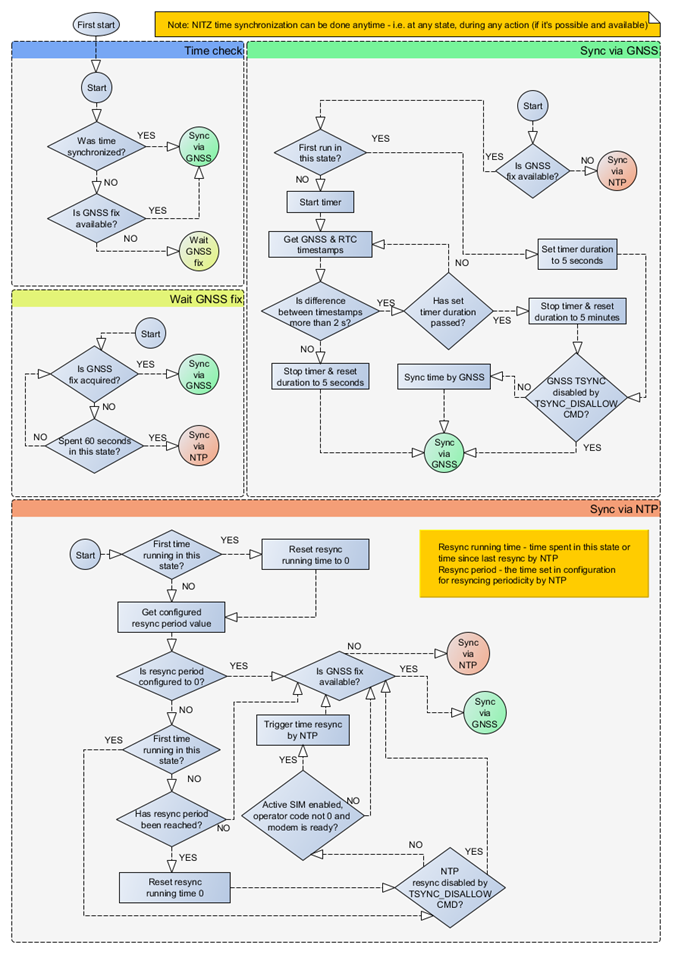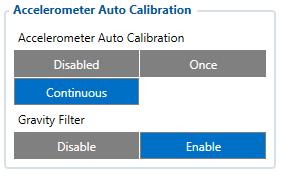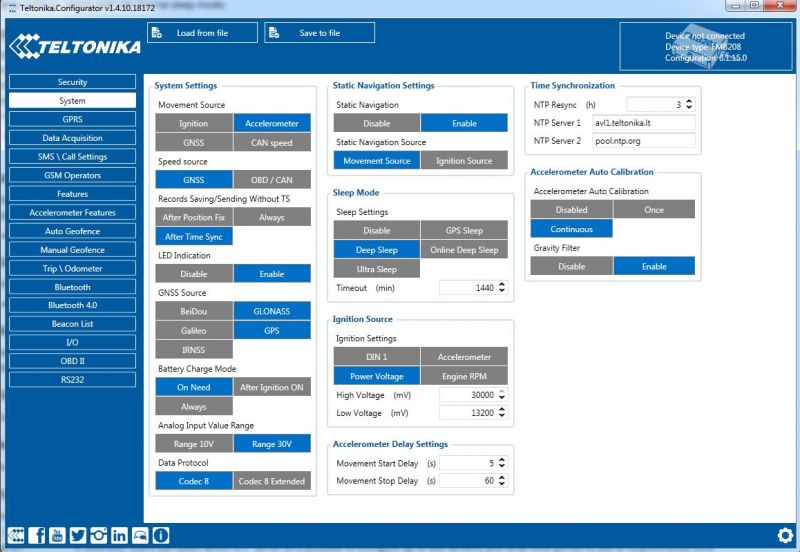FMB208 System settings: Difference between revisions
Created page with "{{ Template:FMB208 System settings |model=FMB208 |template_link={{Template:FMB1 Movement parameters}} |ctrDaq=Data acquisition settings }}..." |
m Protected "FMB208 System settings" ([Edit=Allow only administrators] (indefinite) [Move=Allow only administrators] (indefinite)) |
(No difference)
| |
Revision as of 21:06, 2 April 2020
Main Page > Advanced Trackers > FMB208 > FMB208 Configuration > FMB208 System settingsSystem settings have the following configurable parameters:
Sleep Settings
Sleep Settings, where user can choose sleep mode;
Ignition Source
Ignition Source, where the user can choose an ignition source from digital input 1, power voltage, engine RPM and accelerometer. More than one ignition source can be selected at the same moment. When there are 2 or more sources selected, at least one condition has to be met to change Ignition status. Example: DIN1 and Accelerometer are selected as the Ignition source. When the device detects movement, Ignition status will change to 1, regardless that DIN1 value is 0. Users can select movement start and movement stop delay time - those parameters are used when the accelerometer is selected as an ignition source. Ignition status is used in power management and the following functionalities: eco-driving, excessive idling, fuel consumption, over speeding, towing and trip;
- Object motion detection settings, where user can configure 4 ways how FMB208 detects movement and change its working mode (for more information refer to section Data acquisition settings). Other functionalities that depend on movement source are: power manager, fuel consumption and trip;
Static Navigation Settings, where users can turn static navigation on or off. Additionally, the user can choose which source (movement or ignition) is used to activate/deactivate static navigation;
- Records settings, where user can enable or disable records when GPS is not available (no time synchronization);
GNSS Source
GNSS Source settings, where user can choose the necessary satellite system(s);
- LED Indication, where user can turn on or off the indication LEDs;
Battery Charge Mode
Battery Charge Mode, where user can choose when battery will be charged: On Need (battery will be charged anytime when it needs to be charged) and After Ignition ON (battery will be charged only when ignition is on);
Data Protocol
Data Protocol where user can choose which protocol version to use for data sending to the server;
Analog Input Value Range
Analog Input Value Range where user can choose analog input range of 10 V or 30 V;
Time Synchronization*
Time Synchronization settings, where the user can choose which source(s) to use for FMB208 time synchronization. User has a choice to: use only one synchronization source (Disable (GPS only)), allow synchronization from both the GNSS and NTP server (NTP), select synchronization through GNSS and GSM operator (NITZ) or from all three sources (when NITZ+NTP is selected). Users can select which NTP server (it is possible to configure up to two servers) and what time period to use to resynchronize time.
- using 03.25.13 or older firmware
New time synchronization method implementation*
From 03.25.14 firmware the new time synchronization works by waiting a minute on startup to acquire fix and consequently synchronizes the time via GNSS.
This state checks the difference between RTC and GNSS times every second. If the difference of at least 3 seconds persists to be for 5 seconds, the firmware triggers a resynchronization procedure by GNSS.
After that, the time difference is still calculated, but the difference is expected to persist for at least 5 minutes to trigger a GNSS time resynchronization.
In the case that there is no fix or it is lost during the syncing by GNSS state, the firmware goes to the state of syncing by NTP. Entering the state of NTP syncing, the firmware immediately attempts to synchronize the time by triggering NTP and later on, does this periodically every time the configured NTP resynchronization time is reached (if the resynchronization time is set to 0 – no NTP sync is performed at all). Time synchronization by NITZ can occur at any time.
- using 03.25.14 or newer firmware

Accelerometer Auto Calibration

User can disable or enable Accelerometer Auto Calibration and Gravity Filter features. This Feature is available from firmware version 03.25.07.Rev.00. Under Accelerometer Auto Calibration settings, user can choose:
* Disable – do not use auto calibration feature (sends AXES raw data).
* Once – calibrate one time only.
* Continuous – continuously analyzes current data and re-calibrates if needed.
Important! If Auto calibration is disabled, device should be mounted according User manual for EcoDriving feature to work properly. If enabled, AXES will be reoriented to VEHICLE axes according User manual (+X – Forward, +Y – Left, +Z – Down).
Gravity filter substracts gravity from vector when devices is calibrated or if auto-calibration is disabled (default values). Gravity is only removed when gravity filter is enabled.
Filter settings, user can choose:
* Disabled – do not remove GRAVITY component from AXL/Crash data.
* Enabled – remove GRAVITY component from AXL/Crash.
Note: In FM*0YX devices autocalibration is set by default and it is not configurable via configurator. Device connected to OBD port is not positioned accoring to the vehicle axis and in this case autocalibration is must.
Multiple Movement Sources
From new firmware version 03.25.14.Rev.03 added new multiple movement sources selection at once. If any of selected movement sources are active, movement mode will be activated. If all selected sources are inactive STOP mode will be enabled. Configurable movement parameter ID has been changed. Information regarding configurable parameter ID could be found in the table below:
| Firmware version until 03.25.14.rev.03 | Firmware version from 03.25.14.rev.03 |
|---|---|
| 100 - Parameter ID | 138 - Parameter ID |
| Movement source | Vehicle on Stop mode | Vehicle Moving mode |
|---|---|---|
| Ignition (recommended) | If ignition (ignition source) is logic low. | If ignition (ignition source) is logic high. |
| Accelerometer (internal movement sensor) | Accelerometer (internal movement sensor) does not detect movement. | Accelerometer (internal movement sensor) detects movement. |
| GNSS | GPS fix is available and vehicle speed is lower than 5 km/h. | GPS fix is available and vehicle speed is higher than 5 km/h. |
| While GPS fix is unavailable, Object Motion Detection Settings are working like in Msensor mode. | ||
| CAN speed | If speed from BT OBDII dongle is equal to 0 km/h. | If speed from BT OBDII dongle from BT OBDII dongle is higher than 0 km/h. |
Static Navigation mode is a filter, which filters out track jumps when the object is stationary. If static navigation filter is disabled, it will apply no changes to GPS data. If static navigation filter is enabled, it will filter changes in GPS position if no movement (as defined by configured movement source) or ignition (as defined by configured ignition source) is detected. It allows filtering GPS jumps when the object is parked (not moving) and GPS position is still traced.

In GNSS Source settings user can configure which GNSS system(s) to use.
User has a choice to use only one system between GPS, GLONASS, Galileo or Beidou and it is possible to choose two or three systems together. One exception is that you cannot combine BeiDou and GLONASS systems together. Examples of non-configurable GNSS source combinations are:
- GLONASS + BeiDou;
- Galileo + GLONASS + BeiDou;
- GPS + GLONASS + BeiDou;
- GPS + Galileo + GLONASS + BeiDou.
List of configurable GNSS sources:
| Selected source(s) | ID |
|---|---|
| BeiDou only | 01 |
| GLONASS only | 02 |
| Galileo only | 04 |
| Galileo + BeiDou | 05 |
| Galileo + GLONASS | 06 |
| GPS only | 08 |
| GPS + BeiDou | 09 |
| GPS + GLONASS | 10 |
| GPS + Galileo | 12 |
| GPS + Galileo + BeiDou | 13 |
| GPS + Galileo + GLONASS | 14 |
